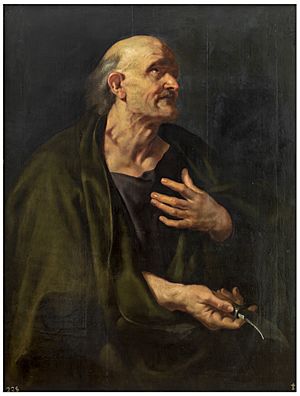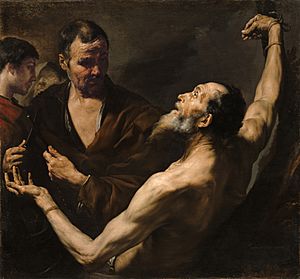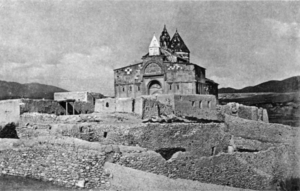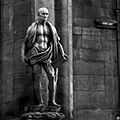Bartholomew the Apostle facts for kids
Quick facts for kids SaintBartholomew the Apostle |
|
|---|---|

St Bartholomew (c. 1611) by Peter Paul Rubens
|
|
| Apostle and Martyr | |
| Born | c. 1 AD Cana, Galilee, Roman Empire |
| Died | c. 69 AD Albanopolis |
| Venerated in | All Christian denominations which venerate saints |
| Major shrine | Saint Bartholomew Monastery in historical Armenia, Saint Bartholomew Church in Baku, Relics at Basilica of San Bartolomeo in Benevento, Italy, Holy Myrrhbearers Cathedral in Baku, Azerbaijan, Saint Bartholomew-on-the-Tiber Church, Rome, Canterbury Cathedral, the Cathedrals in Frankfurt and Plzeň, and San Bartolomeo Cathedral in Lipari |
| Feast | 24 August (Western Christianity) 11 June (with St. Barnabas) (Eastern Christianity) 25 August (Translation of relics, with Saint Titus) (Eastern Christianity) |
| Attributes | Red Martyrdom |
| Patronage | Armenia; Azerbaijan; bookbinders; butchers; Florentine cheese and salt merchants; Gambatesa, Italy; Catbalogan, Samar; Magalang, Pampanga; Malabon, Metro Manila; Nagcarlan, Laguna; San Leonardo, Nueva Ecija, Philippines; Għargħur, Malta; leather workers; neurological diseases; skin diseases; dermatology; plasterers; shoemakers; curriers; tanners; trappers; twitching; whiteners; Los Cerricos (Spain); Barva, Costa Rica |
Bartholomew was one of the twelve apostles of Jesus. His name comes from an Aramaic phrase meaning "son of Talmai." He is often thought to be the same person as Nathanael, who is mentioned in the Gospel of John. Nathanael was introduced to Jesus by Philip, who also became an apostle.

Contents
Bartholomew's Journeys and Teachings
After Jesus went to heaven, Bartholomew traveled to many places to share the Christian message. This is known as a missionary tour.
Eusebius of Caesarea, a historian from the early 300s AD, wrote that Bartholomew went to India. There, he left a copy of the Gospel of Matthew, one of the books in the New Testament. Other stories say he also taught in Mesopotamia, Parthia, Lycaonia, and Ethiopia.
Mission to India
Two old writings mention Saint Bartholomew's trip to India. These are from Eusebius of Caesarea and Saint Jerome, both from the 300s AD. They talk about Bartholomew's mission when discussing another saint, Saint Pantaenus, who visited India in the 100s AD.
Some researchers believe Bartholomew's missionary work happened in the Bombay region of India. This area might have been known as the ancient city of Kalyan. However, many scholars are still unsure if Saint Bartholomew truly went to India. Some think the "India" mentioned by Eusebius and Jerome might have been Ethiopia or Arabia Felix.
Bringing Christianity to Armenia
Along with another apostle, Jude "Thaddeus", Bartholomew is believed to have brought Christianity to Armenia in the 1st century. Because of this, both saints are considered the patron saints of the Armenian Apostolic Church.
A popular belief says that Apostle Bartholomew was killed in Albanopolis in Armenia. However, some modern studies suggest he might have died in Kalyan, India.
The Saint Bartholomew Monastery was a large Armenian monastery built in the 1200s. It was located where people believed Apostle Bartholomew was martyred in historical Armenia. Today, it is in ruins in southeastern Turkey.
Bartholomew in Azerbaijan
The Saint Bartholomew Church (Baku) was built in 1892 in Baku, Azerbaijan. It was built with donations from local Christians. People believed it was the spot where Apostle Bartholomew was killed. It is thought that near the Maiden Tower, Bartholomew was crucified and killed by non-Christians around 71 AD. The church was used until 1936, when it was torn down during a time when the Soviet government was against religion.
Honoring Saint Bartholomew
Different Christian groups honor Saint Bartholomew on specific days. The Coptic Orthodox Church remembers his martyrdom on September 11. Eastern Christianity celebrates him on June 11. The Catholic Church honors him on August 24.
The Church of England also remembers him with a special day on August 24. The Armenian Apostolic Church honors Saint Bartholomew and Saint Thaddeus as their patron saints.
In Azerbaijan, the Catholic Church and Russian Orthodox Church honor Saint Bartholomew as the Patron Saint of Azerbaijan. They believe he brought Christianity to the region. His feast day is celebrated on August 24 by Christians there.
Saint Bartholomew's Relics
Relics are parts of a saint's body or belongings kept as a reminder of them. A writer from the 500s, Theodorus Lector, said that around 507 AD, the Byzantine emperor Anastasius I Dicorus gave Bartholomew's body to the city of Daras.
Later, a large piece of his skin and many bones were kept in the Cathedral of St. Bartholomew in Lipari, an island off Sicily. In 838, these relics were moved to Benevento, Italy, where they are still kept today in the Basilica San Bartolomeo.
In 983, some of the relics were given to Rome. They are now kept at San Bartolomeo all'Isola, a church built on the site of an old Roman medical center. Because of this, Bartholomew's name became linked to medicine and hospitals. Parts of his skull are in the Frankfurt Cathedral, and an arm is in Canterbury Cathedral.
In 2003, Bartholomew I of Constantinople brought some of Saint Bartholomew's remains to Baku. These are now kept in the Holy Myrrhbearers Cathedral.
Amazing Stories and Miracles
People tell many stories about miracles performed by Bartholomew, both when he was alive and after his death. Two famous stories come from the small Italian island of Lipari.
The people of Lipari celebrate his feast day every year. They carry a heavy silver and gold statue of Saint Bartholomew through the town. One time, as they carried the statue down a hill, it suddenly became very heavy. They had to put it down. They tried again, but it got even heavier. They put it down one last time. Moments later, walls further down the hill collapsed. If the statue had been moved, many townspeople would have been hurt or killed.
During World War II, the government wanted to melt down the silver statue to get money. But when they weighed the statue, it was found to be only a few grams. So, it was returned to the Cathedral of Lipari. In reality, the statue is made of many kilograms of silver. People believe it was a miracle that it was not melted down.
Saint Bartholomew is known for many other miracles involving the weight of objects.
Art and Literature

Saint Bartholomew is a very important Christian martyr. In art, he is often shown with a chained demon. He also appears in many beautiful medieval books.
The Florentine artist Pacino di Buonaguida showed Bartholomew's martyrdom in a detailed painting from around 1340.

Bartholomew is the patron saint of many professions, including tanners, plasterers, tailors, leatherworkers, bookbinders, farmers, housepainters, butchers, and glove makers.
The painting The Martyrdom of Saint Bartholomew (1634) by Jusepe de Ribera shows Bartholomew's final moments. The artist wanted viewers to feel for Bartholomew, who seems to be reaching out to a bright light. His strong faith is clear, even as he faces torture. The painting focuses on the deep feelings of the people involved.
Bartholomew is also mentioned in Francis Bacon's story New Atlantis. This story is about a hidden land called Bensalem. In the story, people in Bensalem found a special ark floating in the sea. It contained a letter from Bartholomew and books of the Old and New Testaments. The letter said an angel told him to send the ark. This way, the people of Bensalem received God's message.
Cultural Celebrations
The festival in August has long been a time for markets and fairs. For example, the Bartholomew Fair was held in Smithfield, London, for many centuries. It was even the setting for Ben Jonson's play Bartholomew Fair in 1614.
The St Bartholomew's Street Fair is held every year in Crewkerne, Somerset, England. This fair dates back to Saxon times. It was a major trading market mentioned in the Domesday Book. The fair is believed to have received its official permission from King Henry III (1207–1272). The oldest record of the fair is from 1280.
Bartholomew in Islam
The Qur’an, the holy book of Islam, talks about the disciples of Jesus. However, it does not give their names or detailed stories about their lives. Muslim scholars generally agree with the New Testament list of disciples. This list includes Peter, Philip, Thomas, Bartholomew, Matthew, Andrew, James, Jude, James the Less, John, and Simon the Zealot.
Images for kids
-
Saint Bartholomew in Michelangelo's The Last Judgment.
-
Statue of Bartholomew at the Archbasilica of St. John Lateran by Pierre Le Gros the Younger.
-
St Bartholomew ..., by Marco d'Agrate, 1562 (Duomo di Milano)
See also
 In Spanish: Bartolomé el Apóstol para niños
In Spanish: Bartolomé el Apóstol para niños
- Gospel of Bartholomew
- Questions of Bartholomew
- Acts of Andrew and Bartholomew
- St. Bartholomew's Day massacre
- St Bartholomew's Hospital
- Bertil
- Saint Bartholomew the Apostle, patron saint archive









